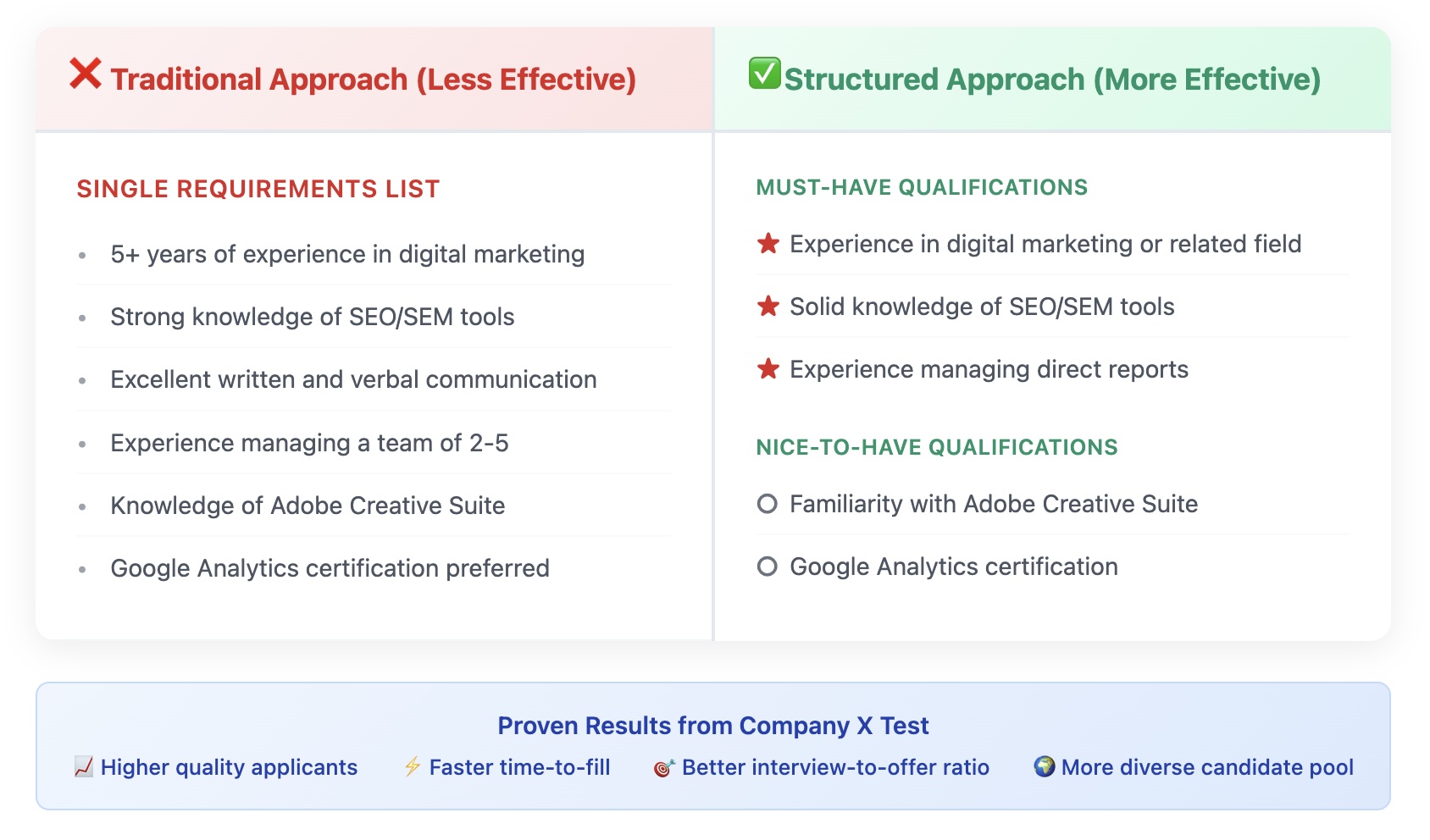Traditional hiring practices have long relied on filtering factors such as college degrees and work experience. While a prospective employee’s education and prior employment can be valuable assets, only applying those filters may exclude a huge swath of talented job seekers. Considering a skills-first hiring approach may reveal some hidden gems in the pool of candidates.
What is Skills-First Hiring?
Skills-first (or skills-based) hiring is the practice of primarily assessing job candidates based on their demonstrable job skills rather than education or work experience. Skills-first evaluation gives priority to all kinds of job skills: leadership abilities, effective communication, as well as industry-specific work such as programming, project management, or AI proficiency.
The pandemic dramatically and suddenly altered the job market in ways that continue to affect many industries. It disrupted people’s educational efforts, changed career trajectories, impacted companies’ ability to maintain a consistent workforce, changed production and distribution of products, and dramatically affected imports and exports. In the aftermath and recovery, companies were met with extreme labor shortages and a demand to rethink what made a job candidate viable.
A skills-first hiring approach acknowledges that the gap between a high-school diploma and a college degree is filled with candidates who possess tremendously valuable job skills, and excluding them may keep companies strapped for talent.
Why Should You Consider Skills-First Hiring?
The 2022 United States Census revealed that 37.7 percent of the adults over the age of 25 have a bachelor’s degree, a statistic that has not risen significantly since 2020, when it was 37.5 percent. Since the workforce is populated by many more adults than have college degrees, a huge swath of workers are developing marketable skills when given opportunities for on-the-job training and mentorship.
A study conducted by Harvard Business Review found that this shift has happened in part because of “increasing demand for digital proficiency in an ever-greater percentage of positions . . . and a deeper understanding of the specific competencies required in today’s emerging occupations.” Many of these skills are well-developed with daily practice at work. Further, rapid growth in online credentialing and learning platforms offers alternative pathways to acquiring key skills, helping to facilitate this transition.
Hiring with a skills-first approach can help previously marginalized communities with positive career advancement, and help companies meet goals and initiatives. The same Harvard Business Review study found that workers without a bachelor’s degree who are hired for a role that previously required a degree earn an average of 25 percent more than they would in a role that didn’t require it. This estimate amounts to more than $12,400 in incremental earnings annually.
In 2021, McKinsey found that 87 percent of companies believe they are in the midst of or will experience a skills gap among workers. That’s a number that proves the necessity of adjusting the old ways of hiring. In an extremely competitive job market, companies who distinguish themselves with a more expansive attitude towards hiring can attract hidden talent.
How Can My Company Implement Skills-First Hiring?
While no one is claiming that jobs like doctors or attorneys should be staffed with people without degrees, jobs like web designers, HR managers, facilities managers, and industrial designers are often staffed by competent and skilled workers without degrees. The study found large statistical gaps between people occupying those jobs without degrees and job postings that required them. For web designers, for example, the gap was 20 percent.
As you identify hiring needs in your company, you can take a hard look at factors that contributed to hiring in the past:
- How quickly did you find the right candidate?
- Was the job open longer than intended while waiting for a so-called “perfect” candidate?
- How was the hiring budget spent (on recruiting, job posting sites, etc.)?
- Were otherwise qualified prospective employees eliminated in the first cull because of degree status?
A tool like ApplicantStack can provide the data for this self-analysis. Sorting prior job applicants by qualifications gives you great insight into who made the cut for further interviews and why.
Steps to Create a Skills-First Hiring Paradigm
Follow these steps to make the shift toward a skills-first hiring attitude in your organization.
Change Internal Hiring Policies
While this step may seem obvious and simple, evidence suggests that four out of five hiring managers may be resistant to removing a degree requirement, believing it’s the best indicator for a valuable skill set. Adjusting these policies gives the hiring staff freedom to develop a new set of job requirements that can include hard and soft skills.
Identify Needed Skills
A recent Deloitte report found that 80 percent of workers are willing to provide information about demonstrated skills and capabilities, while 7 in 10 are willing to have data collected regarding their potential abilities. Using care and discretion, you can evaluate the vital skills that current employees use in the daily execution of their tasks.
Identifying and naming required skills can help you sort through future applications with a wider variety of categories and markers. This effort can also help with assigning roles to current employees based on their individual skills instead of a more broad and potentially limiting job title.
Rewrite Job Descriptions
Resistance to the idea of skills-first hiring means some hiring managers don’t want to explicitly invite candidates without a degree to apply, preferring more vague references. In its study, HBR found that only about a third were willing to remove references to degree requirements. That same Deloitte report found that organizations with a skills-based approach are:
- 107% more likely to place talent effectively
- 98% more likely to retain high performers and have a reputation as a great place to grow and develop
Writing new job descriptions will remove the ambiguity that can discourage job seekers from applying in the first place. Focus on writing job descriptions that emphasize that job skills are as (or more) valuable than traditional markers of quality.
Provide Continual Training
“Employees want to know their employers see their value and potential,” says Michele Sims at Forbes. “They want to grow, excel, advance their careers and be supported throughout that journey.” Beyond just hiring for skills, your company can offer training, mentorship, advanced certifications in their field, and opportunities for advancement and promotion commensurate with their contributions and work experience.
The ever-changing job market requires hiring managers to adapt to worker shortages, stiff competition for talent, and releasing themselves from traditional methods that may severely limit your company’s access to the candidate pool. A skills-first hiring approach can both cast a wider net for untapped talent and contribute to job satisfaction and retention.
Explore how ApplicantStack can simplify the hiring process and ensure that you never miss a qualified candidate. Post your first job for free now!











